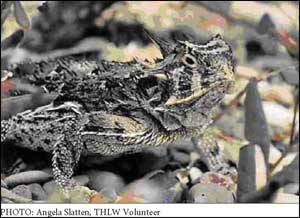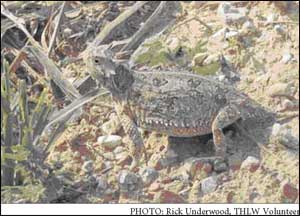Texas Horned Lizard Watch 10-Year Summary Report
Conclusions and Recommendations
During its initial 10 years, Texas Horned Lizard Watch has produced both public enthusiasm and insightful results. One notable accomplishment is an ongoing refinement of the current distribution map for the species. Whereas recent scientific surveys (Donaldson et al. 1994; Henke 2003) and our survey of TPWD biologists produced pessimistic results for the eastern third of the state (especially in those areas lying north and east of IH-35 and IH-37; see fig. 13), our project volunteers have provided encouraging results from the Post Oak Savannah ecoregion, the barrier islands of coastal counties, and the Dallas/Fort Worth Metroplex. These populations may be small and isolated and merit additional attention to assess their viability and conservation. On the other hand, volunteers confirm some pessimism for Central Texas, especially the eastern Edwards Plateau ecoregion, and have documented a decline of the species in some urban centers in West Texas. The project will continue to try to "fill in the gaps" regarding current distribution of the species.

Texas Horned Lizard
Photo by Courtesy of Angela Slatten, THLW Volunteer
Texas Horned Lizard Watch has also offered some insight into habitat relationships for the species based on simple presence/absence data. Most notably, volunteer results are the most conclusive data set in existence regarding relationships between red imported fire ants and horned lizards. Previous work has postulated that red imported fire ants may have negatively impacted Texas Horned Lizards (Allen et al. 2004; Donaldson et al. 2004; Henke 2003), and our volunteer data demonstrate a statistically significant negative relationship between the two species. Red imported fire ants may not have been the primary factor contributing to horned lizard decline; however, these findings suggest that recovery efforts will have to address their management in order to be successful. Volunteer data have also consistently shown a positive relationship between horned lizards and harvester ants and, in some years, suggested a negative relationship between harvester ants and red imported fire ants. Some years of data have implied a relationship between Texas Horned Lizards and land use or soil type, but pooled data do not reveal a clear relationship. More conclusive results for these variables are probably limited by the small number of data sheets from some land use types, as well as a tendency for volunteers with negative results to fail to send in data sheets.

Texas Horned Lizard
Photo by Courtesy of Rick Underwood, THLW Volunteer
The watch program has not fulfilled all initial expectations, however. It was hoped that the monitoring program might provide a quantitative measure of horned lizard abundance over time. Initial results showed that quantitative measures by so many different volunteers produced results that were highly variable and that many volunteers preferred a less strictly quantitative approach. Furthermore, ongoing research shows that sampling must be very intensive to detect changes in density of the species (based on a personal communication with Chip Ruthven). These results led to a shift in emphasis to qualitative results regarding horned lizards and their habitat. In addition, most volunteers did not choose to continue monitoring year after year, leading to snapshot-type data rather than trend data. When contact was reestablished with some of the early volunteers in 2007, however, many indicated that they would be willing to participate again. The Texas Parks and Wildlife Department is also in the process of making data entry available online, with the hope that this will encourage both continued and new participation.
On the whole, Texas Horned Lizard Watch has been very successful in its attempt to engage citizens in meaningful, hands-on research. Participants are overwhelmingly enthusiastic, with many offering much more information and research than required by the data sheets. The personal recollections offered by watch participants were the inspiration for an essay contest conducted from 2001 through 2006 called "Hometown Horned Toads," that was designed to capture oral histories about people's experiences with horned lizards and their observations about their decline. Not only have the results of Texas Horned Lizard Watch been poignant, but they have also been significant. Results have been presented at scientific meetings, distribution data has been used in project planning, and habitat relationships have been used to offer management advice. The project will continue and will be modified in future years to increase participation, refine habitat data, assess trends through maintaining contacts with initial participants, and incorporate data on the other two horned lizard species in Texas.
Top of Page^
 (
(